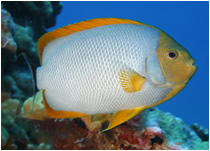Endemic Sea Life in Papahānaumokuākea Marine National Monument
 Papahānaumokuākea is characterized by a high degree of endemism in reef fish species, particularly at the northern end of the chain, with endemics comprising over 50% of the population in terms of numerical abundance (DeMartini and Friedlander 2004). Endemism of corals is also high, with 30% of species being found only in the Hawaiian Archipelago. These endemics also account for 37%–53% of visible stony corals found in Papahānaumokuākea in all shallow reef areas surveyed (Friedlander et al. 2005). Fifteen of the 17 endemic species are in the genera Montipora, Porites, or Pocillopora. Due to Papahānaumokuākea’s remoteness, studies of small benthic or cryptic species are sparse, but with the inception of National Monument status, there have been increased efforts to document these groups. Preliminary faunal inventories indicate that many constituent species remain undocumented, and even new coral species are still being discovered. This tailored attunement of species to a specific place is called endemism. No other coral reefs of similar size and expanse on the planet have a higher rate of endemism than Hawai‘i’s.
Papahānaumokuākea is characterized by a high degree of endemism in reef fish species, particularly at the northern end of the chain, with endemics comprising over 50% of the population in terms of numerical abundance (DeMartini and Friedlander 2004). Endemism of corals is also high, with 30% of species being found only in the Hawaiian Archipelago. These endemics also account for 37%–53% of visible stony corals found in Papahānaumokuākea in all shallow reef areas surveyed (Friedlander et al. 2005). Fifteen of the 17 endemic species are in the genera Montipora, Porites, or Pocillopora. Due to Papahānaumokuākea’s remoteness, studies of small benthic or cryptic species are sparse, but with the inception of National Monument status, there have been increased efforts to document these groups. Preliminary faunal inventories indicate that many constituent species remain undocumented, and even new coral species are still being discovered. This tailored attunement of species to a specific place is called endemism. No other coral reefs of similar size and expanse on the planet have a higher rate of endemism than Hawai‘i’s.
